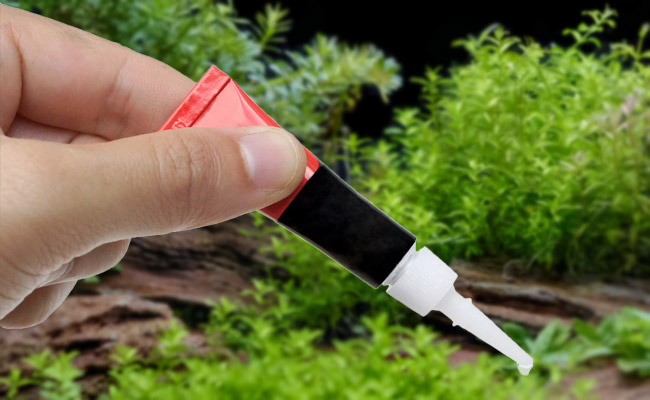
I think you’ll agree with me when I say:
There is not a lot more frustrating than waking up to discover that the moss and other saplings you planted the night before are all floating on the surface of your aquarium.
Weighing them down is not always practical. And, tying them with string is so fiddly.
That’s why my go-to solution for keeping plants in place is…
Glue!
In fact, if you want to stick something to anything in your aquarium, glue is often the best way to go about it.
But you need the right glue. One that you can easily apply, even wet.
Forget reaching for a tube of silicone – it takes too darn long to set and is best used for sealing and repairing.
And, don’t even think about buying one of those “special aquarium glues.” Not saying they don’t work, but they are much more expensive than they should be!
When it comes to gluing down anything in your aquarium – rocks, gravel, plants or decorations – there is just one tube of glue that you need to reach for…
Cyanoacrylate gel… Better known as super glue gel!
I love that they come in a pack of 12 for one low price. And, considering that you can use this glue for more than just your aquarium, keeping spare tubes on hand always comes in handy. Affordable and effective, it’s all you’ll ever need.
Why super glue gel?
Well, it’s easy to dispense, holds tight and dries quickly – you know, all the stuff that you would expect from glue.
But it has one more trick up its sleeve…
You can use this glue under water!
Yep, this glue is essentially waterproof. I cannot begin to tell you just how useful this stuff is…
Have a piece of driftwood in your planted tank that you want to glue some plants to? Not a problem, you don’t even need to take it out of the tank.
Airline tubing falling off the suction cups? No worries – underwater glue to the rescue!
Moss floating up from your gravel? Stick it down!
Glue decorations and ornaments to rocks or even rocks together.
You get the idea, this stuff is darn handy – it’s basically an aquascaper’s best friend.
And best of all, it’s harmless to your fish. Yep, 100% aquarium-safe. In fact, this is basically the same stuff that dedicated aquarium brands use as their glue – they just repackage the glue and market it to fish keepers.
Now that you have the glue, it’s time to show you how to use it…
Contents
How to glue aquarium plants
Chances are you have used super glue before. But just on the off chance you haven’t, I’m going to take you through gluing plants to a piece of driftwood.
Here is a piece of driftwood – lovely spiderwood…
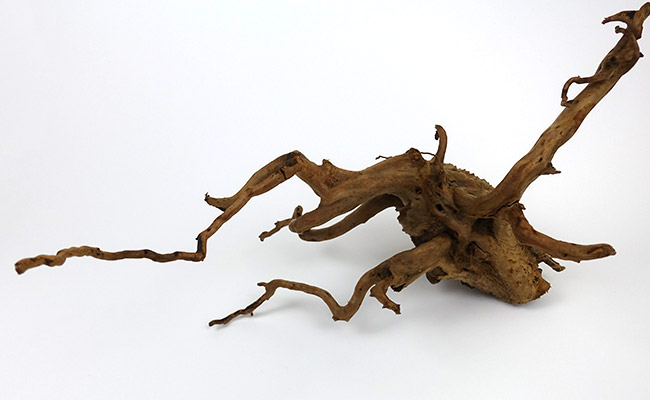
It’s a little plain, right?
That’s why I’m going to glue some plants on, to add a bit of color…
Prepare what you need to glue
Okay, so the first thing I like to do is prepare the surface I am going to glue to. While this isn’t the most important step when used outside of water, I recommend it when you will place it under water – wipe away that layer of slime to give the glue the best chance of bonding.
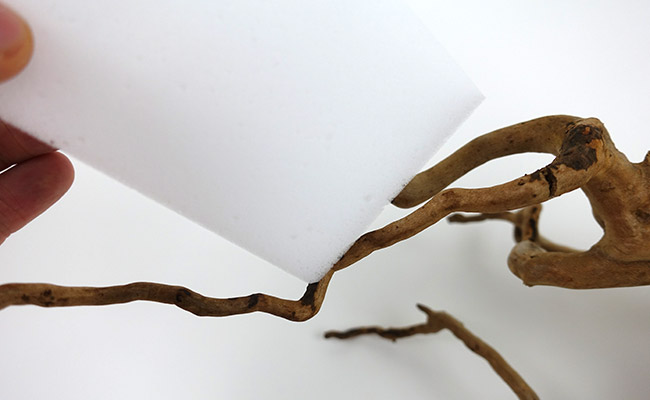
I personally use melamine foam. It’s cheap, can be cut into smaller pieces and can remove almost anything from anything.
This is the same material used in those Mr. Clean Magic Erasers and are another awesome product you should always have on hand. I also use this foam to wipe down the aquarium glass for a sparkling finish and, just yesterday, I used it to effortlessly remove my nephew’s “artwork” that he drew on the walls… Great stuff!
Gluing the plants and stickers
Okay, back to gluing…
The next step is to grab your plant…
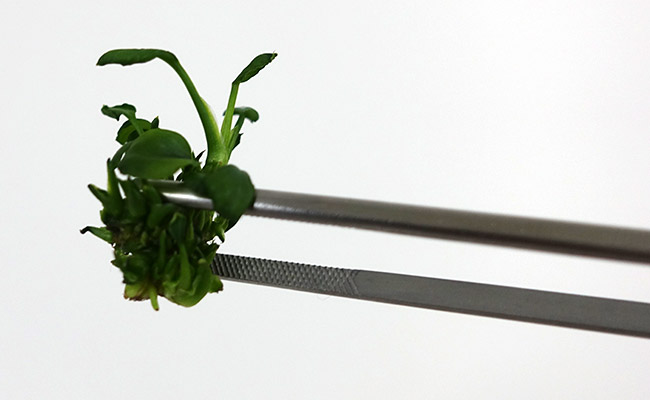
I am going to be using an anubias nangi sapling. A great beginner plant that looks awesome on driftwood. It’s looking a little worse for wear now, but don’t worry! It will burst back to life once I get it back under water.
But first, we have to glue this sucker into position.
So, turn the plant over and apply a generous dollop of glue!
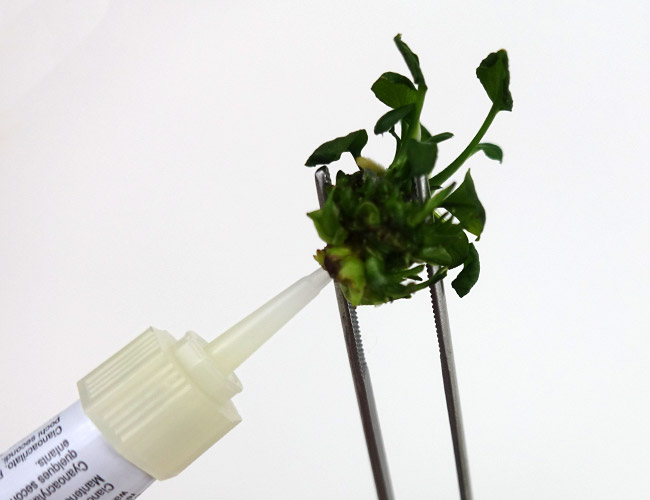
Be quick, this stuff dries fast!
All that’s left to do is press the plant down onto the section that you prepared earlier…
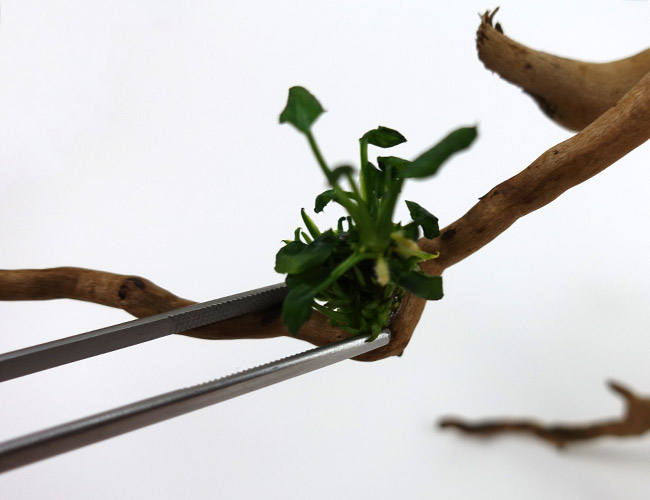
Hold it for a few seconds
You only need to hold it in place, applying pressure for a slow 5 count. If you used enough glue, the glue should now support the plant without your help.
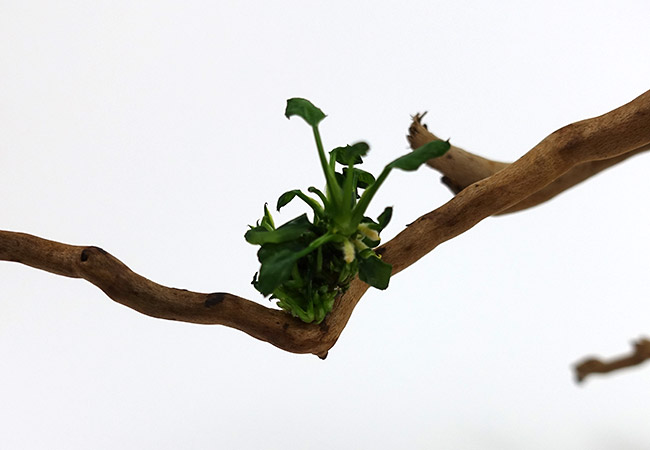
Hooray! We did it… Pretty simple, huh?
Now, all that’s left to do is to repeat until I have my driftwood covered in beautiful aquarium plants!
Don’t forget to put the cap back on the glue when you are finished. You don’t want the glue drying out and going to waste.
Stay Careful with Aquarium Glue
A word of warning, super glue gel dries white. And, it is very visible under water. This isn’t an issue at all for plants, which are just going to grow over it anyway, hiding it from view.
But a messy glue job on anything else, like decorations, can be much more difficult to hide. But if you have a steady hand and are neat with the glue, you can make a bond that is practically invisible.
One final thought before I leave you – be careful. This is super glue. This stuff is designed to stay stuck. Always read the directions before use.
Do you use glue in your aquarium? Let me know in the comments below!

Ian Sterling, founder of Fishlab.com, began his aquarium journey over 30 years ago, driven by a deep fascination for fish and their diverse personalities. His website, Fishlab.com, is dedicated to making fishkeeping accessible and enjoyable, offering beginner-friendly guidance, expert insights, and a community for aquarists to connect and share experiences.


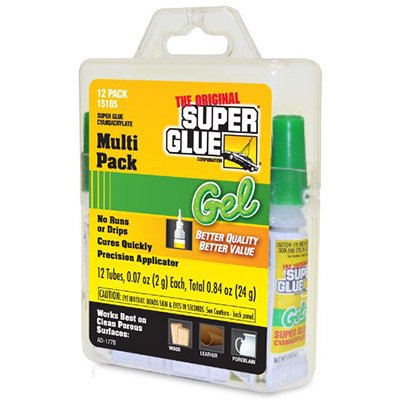
Comments (71)
You are correct. this glue works good. It has hold my plants down for a long time now. I think I bought too many though. I don’t need that much glue.
Hi Hassan,
Thanks for your feedback. Yep, this glue is good stuff for when you want something stuck in a hurry. Hold on to that glue, you might not have a use for it now but I’m sure it will come in handy in the future.
I sounds like once I glue something in to the aquarium, it’s forever. I want to glue something to the glass but I don’t want it to be white and I don’t want it to be permanent. I guess super glue is not for me.
Hi Ira,
Why not try an aquarium safe silicone instead?
Silicone is easily removable with a razor. If you have a glass tank, it’s the same stuff that is bonding the glass together. It’s still going to be visible, but it won’t be white and can easily be removed.
Does it have to be the gel, or will the thin liquid work too?
Hi Andrea,
If the only ingredient is Cyanoacrylate then it’s safe.
Hello Ian,
Do you mean the normal Super Glue which can be found in any supermarket or Store? Isn’t it harmful for the fish?
Hi Yousouf,
If the super glue in your local store is Cyanoacrylate gel, which is usually a combination of silica and Cyanoacrylate. This can be used in your aquarium. If it makes no mention of Cyanoacrylate then I would be hesitant to use it in your tank.
Hi Ian,
I have a piece of drifwood that i dropped an the a piece of it broke off. What glue could I use to glue it?
Hi Francine.
You can use the same glue that is listed in this guide. Make sure you are neat, the glue will dry white – but it will hold strong!
Can using to much gel super glue make fish sick?
Hi Glenda,
Anecdotally, I have used two whole tubes in a mammoth gluing session and saw no problems with my fish, shrimp or water parameters.
I really appreciate you sharing your expertise with us! I am committed to compassionate pet keeping, which means giving each of my pets the most fulfilling, natural, non-stressful environment I can provide.
Thank you!
Hi Sandy,
Now that’s a mindset I can get behind. Your pets are very lucky to have an owner like you.
Hello, I have a tube of super glue that contains ethyl and the aforementioned cyanoacrylate. Would this be safe to secure pieces of fake plant decor that has since fallen apart?
Hi Fish Momma, Ethyl Cyanoacrlate is the full name, they are not two seperate ingredients. So yes, if this is the only ingredient then it is safe to use inside your aquarium.
I’m building a very large Aquatic Turtle tank for two 8″ aquatic turtles. The dimensions are 4’W x 5’L x 3’H (& 6 4″ 4×4 legs). The tank should hold 160 gallons of water with water level going halfway up the tank. I’m using sealed wood as the main construction. and I want to line the interior of the tank with a big sheet of 20mil LLDPE smooth clear vinyl.
My question is: Can I use the SuperGlue Gel to bond the vinyl to the wood? or should I use Aquatic-safe Silicone? My goal is to keep the Thick vinyl sheet neatly and securely in place against all 5 sides (4 sides + bottom). (of course I will use lots of clamps during the curing process).
Thanks.
Hi Dave,
That sounds like a very interesting project. I wish you much success in it’s construction.
While my experience with bonding vinyl to wood is limited to an unrelated woodwork piece I created years ago, I am doubtful that super glue gel is the correct adhesive to use here. If my memory serves correctly I used some kind of cement adhesive. You would need to research further as to the exact adhesive that is both aquarium safe and suitable, you are creating a very unusual project – my aquarium experience is limited to glass tanks.
I’m screening a partion of my tank of just a small 90 degree corner like a L shape and I want to know can I use super glue to seal all the corners on the inside and out from top to bottom and left to rite its a sort of screen made from tough plastic and being it will be a Sandall xx
Hi Sean,
Ordinarily, for glass dividers, silicone is used to hold them in place. However, these can be pressed against either side of the glass. I’m doubtful superglue would hold. I know that HMEF (hamburger matten Eck filters) use silicone to hold the L-shaped pvc frames against the corner of the tank, so I’d say silicone would likely be a better choice.
Hi Ian,
I’m so glad to have stumbled over this page! I bought my wife an aquarium and want to use Star Wars models from Bandai for the decoration.
Now that the question for aquarium safe glue is answered, I was considering to paint and seal the models. However it seems to be very hard to find creditable information.
I was thinking to use enemal or acrylic paint and seal it of with clear Plasti Dip as it was recommended on YouTube.
Would you have any advise/ideas?
Many thanks in advance:)
Hi Dee,
As long as you seal it, it will be fine. I am unfamiliar with star wars models but you could use Krylon Fusion Clear Coat. Plasti-dip or an two-part epoxy resin would be my choice. The plastidip would be considerably easier to apply.
Your quite informative, glad I found your forum.
Can you use glue from a hot glue gun??
Hi Dolly,
It depends on the glue. If it has additives or mold inhibitors, then no. If in doubt, I wouldn’t use it. However, based on discussions I have had with other fish keepers, it doesn’t appear to hold anywhere near as well as Super Glue Gel, which in my opinion defeats the purpose of it being used as a glue.
Hello Ian,
I have a small outdoor pond made with a pond liner. The liner has developed a small hole and although I patched it with a pond liner repair kit (and followed the instructions faithfully), it looks like the patch is coming loose on one side. Would this glue work for sealing the loose edge of the patch or would water safe silicone work better? My chorus frogs are not at all happy with this latest development! Thanks for your advice!
Phylis
Hi Phylis,
I’m terribly sorry but my expertise only covers aquariums. I have no experience with ponds or liners.
is Dow corning GP silicone okay for pasting Thermocol cement pasted decoration??
Hi Fishman,
I have no experience with Dow Corning GP Silicone. If it’s 100% silicone without additives like fungacides, then it might be okay. If in doubt, don’t add it to your tank.
I completely broke down my 36 gal tank, refilled it and put my fish back in. I “glued” a 5 lb, 13″ tall decor piece to the back of my tank using aquarium silicone, letting it cure for 52 hrs. 1 week has past and the whole thing has slid down the glass, leaving a snotty looking mess. I think I can remove it and scrape off the mess but can I reglue the piece back on using super glue without draining the tank or removing the fish? The back isn’t perfectly smooth, that’s why I thought of using silicone, because I could level it. Would the gel be thick enough to do the same? How long would I have to hold it in place, under water? Lastly, if I want to change the decor in the future, would anything unglue the piece? Thanks.
Hi Nicole,
I can only comment on my experience attempting to glue frags to glass. It didn’t end well, the glue doesn’t hold on glass. 5 lbs is quite heavy to be glued to glass, this is why most of those “concrete” aquarium backgrounds are mostly styrofoam and can be wedged into place. You could experiment, but I’m doubtful superglue will give you the bond you are looking for.
I bought the glue based on your reccommendation. I want to goue rocks together to make a basking dock for my turtles but i read the directions on the case and it says it is NOT for water submission.
Hi Josie,
If it’s Cyanoacrylate gell then it’s fine for aquarium use. Many of the products fishkeepers use for aquariums say “not for aquarium use” it’s likely there to protect the company from a lawsuit. I have used the same brand in the article hundreds of times over, as have many other fishkeepers. Make sure you prep the surfaces of your rocks first before using it for maximum effect!
I was wondering I have two large pieces of Cypress knees I would like to put in my freshwater aquarium. Can I use superglue to glue them to the bottom of the tank to keep them from floating up. If I can in the future will i be able to remove them if needed.
Hi Diane,
If you glue them to a rock or weight and bury the rock in your substrate, then sure. As always, make sure the rock or weight is aquarium safe. Boiling your Cypress Knees, like any other wood, will also help to waterlog them and stop them from floating.
Can you glue to a wet rock?
Hi Jeffry, as long as the rock is clean and not coated in slime, dirt, algae or anything similar then yes.
Thank you Ian
My pleasure!
I’ve read snippets here and there about cyanoacrylate adhesive use in aquariums.
I know superglue is used to hold skin together while it heals (instead of stitches) after surgery. It is a valuable item for first aid.
To ‘plant’ aquarium plants (such as anubias and Java fern) that hate their roots being buried in substrate involved tying them on to something with twine, sewing thread or rubber bands.
The theory being the plant would bond to whatever I attached it to. Sometimes that happened but usually that twine, thread or rubber band disintegrated first. I’d find the plant floating around the tank or sucked up to the filter intake – Not cute IMHO.
I can’t wait to give gel superglue a try at sticking the plants to rocks. Rubber bands, thread and twine look messy and don’t last. Super glue makes more sense than a low temperature hot glue gun!
Hi again Torchstar,
Good as always to hear from you! I personally have a whole bunch of anubias superglued in various lovations to a widely branching piece of driftwood – so that it looks kinda like a tree with leaves, the roots hang down as if they are vines.
It’s been a couple of years now, but all but one have held strong, I suspect I didn’t bond that one properly to the wood. Like you, I found it floating at the top of the tank. It hasn’t moved since I reglued it.
The superglue turns a clear white in the aquarium, it’s very visible at first. But as it gunks up and the plants grow, it soon is unoticable.
I have also had success with fishing line, especially on plants lower in the tank, it blends right in and doesn’t dissolve.
Today was my the first time experimenting with supergluing javaferns to rocks for the goldfish tank…
I picked out a few plants to test the procedure. It was effortless sticking them to to little shiny polished agates! No rough texture necessary. Success!
Next water change???? the rest of the goldfish’s plants are getting glued. No more deteriorating rubber bands or plants drifting to in the way places.
Thanks so much for the time and effort you spend sharing these valuable tidbits of information. Thanks to you Ian I’ve learned an awesome new trick!
Hi Torchstar,
I’m so glad it went effortlessly! Polished agates? Your underwater scape must look stunning, I can only imagine how pretty those would look under water. Thanks for updating me on how it went!
Hi Ian, Thank you for this information! I visited three different stores today and I cannot find Super Glue brand super glue. I purchased Loctite Super Glue Gel Control. Have you used this brand before? The base is Ethyl cyanoacrylate but what worries me is it claims “superior performance over ordinary super glues thanks to a patented additive” but I can’t find what it contains other than cyanoacrylate. The MSDS would not download from the company’s website.
Hi Kara,
I am unfamiliar with Loctite Super Glue Gel Control. Are you able to call the company’s customer service to fine out? If it just has cyanoacrylate, then you are in the clear, but I would be cautious if it contains anything extra.
the product that is shown also contains ethyl cyanoacrylate. there is a close up view of the back label on amazon.
Hi,
i’m contemplating a marine tank and i’ve collected rocks found on the beach (primarily in tide pools or at low tide.) Is it logical to assume these will be safe jn the tank? Also i’ve gathered small crabs, clams and other denizens dead and washed up on the beach or in tide pools. Can these be used safely in a tank and if so, what preparation would be required if any?
Hi Mack,
I would be hesitant to add anything found on the beach into a tank, not only can these contain pollutants (not noticeable in a giant sea, but dangerous in a small tank) but also introduce hitchhikers, bacteria and disease. Keeping an aquarium is a balancing act and it’s often difficult enough to get it right when using properly sterilized or sourced products, let alone stuff found on the ground.
Will the glue eventually dissolve in the water? If you want to remove a plant that has been glued on wood or rock, can the hardened blob of glue be chipped off or removed fairly easily?
Hi Michael,
Excellent question. I have never had any issues scraping superglue off rock or wood once I wanted to re-arrange things in my tank.
I guess I should’ve split these up into two topics. Thanks for answering the second. The first again: will the hardened blob of glue eventually dissolve or lose its adhesive power over time?
Sorry Michael, I missed that. That’s my fault.
The answer for wood here is “it depends” for instance, if you are glueing to wood and it has a bark that peels over time, then as the bark detaches from the wood, so too will the glue, since it is attached to the bark. Same is true of crumbly rocks, if the surface area that the glue is stuck to crumbles, the glue will come unstuck. However, if you are looking at appropriate aquarium decore, this process can take years – as always, for best results, clean and prepare the surface you are gluing too prior. Same is true of what you are gluing too it. For instance, if a plant root dies, and you have used that plant root to anchor with glue, the rest of the plant could detach.
As for the blob of glue dissolving, if it’s superglue gel, it shouldn’t. Anecdotally, I have removed glue blobs years later and they appear to be the same size, although this is going off memory.
Hi! I was wondering if I have to wait any amount of time after gluing the pants onto rocks. I just finished gluing them on and I realized that I might need to wait 24 hours or something and wondering if I have to keep misting my plants or something while I wait.
Hi Hope,
The wonderful thing about superglue gel is that it dries near instantly. A few minutes and it should have adhered.
I just want to double check. If I literally stick a plant INTO THE WATER and hold it down until the glue sets, this will not release any dangerous chemicals that might kill my fish while it dries?
I know that it dries neutral because I’ve always used it, but I would never have dared using it under water with fish swimming around for fear of poisoning them.
Thanks for taking the time to answer this.
Hi Carlos,
Yes. Although the ideal is to apply outside of the tank as it “dries” quick (water is an accelerant for the curing process)
Wait is the glue 100% waterproof because my 80 gallon has airline tubing and it looks really ugly so I want to glue it onto corner of the aquarium. But you see… the tank has water and fish all going already and I’m not going to drain the water so I have to literally squeeze the glue into water and glue it underwater the glue will touch water and I don’t know what’s gonna happen. HELP
Will my fish be affected? Will the water quality be affected? Can I glue the tubing to the aquarium while completely underwater in the tank with fish?
Hi Tom,
A member of my local fish club has used this glue in multiple display tanks without issue.
Hi
My airline tubing in my 80-gallon tank is floating like crazy. Suction cups are useless. I’m wondering if the glue you mentioned above is 100% waterproof and can b applied underwater because I want to glue it to the corner of my aquarium which of course is underwater. I already have water and fish in it so I can’t drain the tank. The glue must be applied 100% underwater and has to cure underwater too. Will the glue float around and kill my fish? or can I apply it underwater completely and not have swings in water parameters and fish deaths.
Hi Tom,
Superglue gel can be used underwater. You will need to use a decent amount, the moment it hits water it will begin to cure, but it’s just the outer membrane. By pressing down on the glue again with pressure, it will burst the membrane and re-glue before it skins over again. It may take a little bit of trial and error, but you’ll get the hang of it. As for the toxicity, local fishclub members have used this in our display tanks without issue.
Hi Ian, my 70 gallon tank developed a leak close to the bottom. I tried many ways to fix it, including draining it past what i think the problem spot is once and resealing with silicone, but it’s not fixed it completely and now it’s worse again. Draining it is not something i can do, I don’t have a way to rehome my fish. I was researching the possible way snd different products snd came across your article. Doesn’t seem like this super glue is my answer though, but I’m looking for underwater product to seal the seam with the fish present. I would appreciate any suggestions from you, as you seem like a very knowledgeable and experienced person. Thanks in advance.
Irina
Hi Irina,
You are correct, superglue gel probably won’t help here. Unfortunately, you are not going to like my answer here – you’ll need to either get a new tank or rehome your fish and reseal your tank. There isn’t really any fish-safe products I know of that will allow you to patch this while wet.
Aquarium munster orca glue!
Hi Marita,
Is this a recommendation for leaky tanks? I’d love to know more, it looks like it’s predominantly available in the EU?
Hello,
I was wondering if this is a brand specific recommendation. Locally we have the Gorilla brand of super glue gel but not the one pictured above.
Thanks!
Hi Erica,
Nope, certainly not brand specific. As long as the only ingredient is Cyanoacrylate, then you are fine.
Hello Ian, I’m makya cave out of lava rock, can I use super glue gel in my goldfish tank? Thanks MikeE
Hi Mike, You can use superglue gel in any aquarium! The fish you keep inside does not make a difference!
Hey Ian,
I followed your advice to glue my liveplantsto myrocks and decorations….question..how do you clean the decorations later …I usually take out the decoration and place it in bleached water for a while….I assume I needto clean now in the tank?? Need to clean algae, etcoff surface…
Hi John,
If the decorations are underwater than carefully wiping them down should work. Plants can survive a bleach dip as long as their roots are not bleached (google bleach dipping plants for more info)
Hello..
I have a snapping turtle, and in his tank i glued down rock to the glass, and now i need to remove the rock as the turtle has grown larger and needs the space.
How do i remove the rock without breaking the glass? It is literally glued to the bottom glass panel of his tank
Hi Ryan,
You would need to deconstruct the tank and use a solvent.